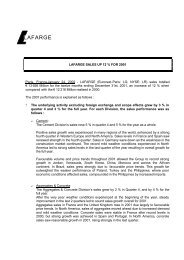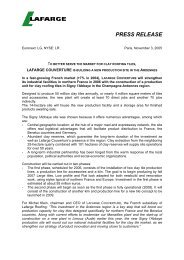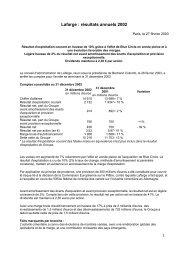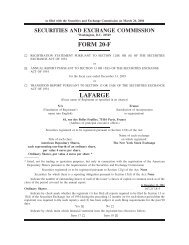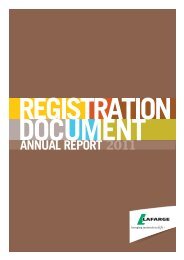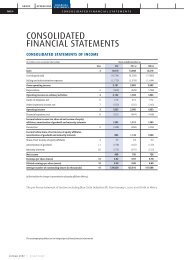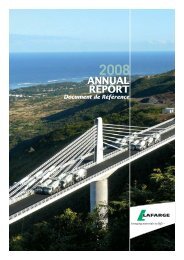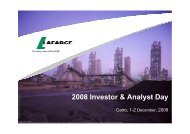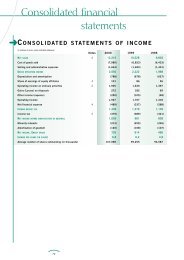2005 Sustainability Report - Lafarge
2005 Sustainability Report - Lafarge
2005 Sustainability Report - Lafarge
You also want an ePaper? Increase the reach of your titles
YUMPU automatically turns print PDFs into web optimized ePapers that Google loves.
Preventing<br />
health risks<br />
CONTINUED PURSUIT OF LAFARGE'S HIV/AIDS PROGRAMS<br />
AND EXTENSION TO MALARIA<br />
<strong>Lafarge</strong>'s commitment to combating public health problems reflects both its ethical commitment and<br />
an economic imperative. For instance, <strong>Lafarge</strong> employs around 7,300 people in ten of the African<br />
countries worst affected by the AIDS epidemic. As a founding member of the Global Business Coalition<br />
on HIV/AIDS, <strong>Lafarge</strong> has set up an African Health Committee since 2000 and given its Business<br />
Units roadmaps and specific budgets.<br />
In <strong>2005</strong>, following the widespread introduction of prevention and testing programs, tritherapies<br />
became available in nine countries for employees and their families. Furthermore, a reporting<br />
system was implemented to monitor treatment and screening-related indicators on a quarterly<br />
basis. In <strong>2005</strong>, 90% of employees participated in the prevention and information programs, with<br />
40% undergoing voluntary screening. Efforts during 2006 will be devoted to the implementation of<br />
prevention, screening and treatment programs in local communities and to adapting and replicating<br />
the program in other countries. These programs are being lauched in certain units in India and China.<br />
Drawing on the experience gained during its efforts to combat AIDS, <strong>Lafarge</strong> has extended its program<br />
to malaria, another debilitating disease found throughout Africa. 90% of <strong>Lafarge</strong>'s units operate in<br />
malaria-endemic regions. The disease accounts for an average of 35% (and up to 70%) of consultations<br />
at the Group's health centers. Along the lines of the managerial model adopted to combat AIDS,<br />
prevention and treatment programs have been set up in seven countries in <strong>2005</strong>. Units in all the<br />
relevant countries have undertaken to implement these programs by year-end 2006.<br />
IMPLEMENTATION OF AN AVIAN FLU ALERT CELL<br />
In September <strong>2005</strong>, the Group set up an avian flu alert cell. Its role is to mobilize the Group's human resources network around the world to coordinate<br />
information, communicate with employees and prevent risks. The final few months of <strong>2005</strong> were spent planning ahead to determine which resources would<br />
need to be implemented and raising general awareness about responsible preventative behavior. The cell's role will also include making emergency<br />
decisions should the animal virus mutate into a form transmissible from human to human. A hotline available round the clock was set up with SOS International<br />
to back up <strong>Lafarge</strong>'s human resources network.<br />
PROTECTING OUR<br />
EMPLOYEES' HEALTH<br />
Keen to protect our employees' health,<br />
we are continuing our efforts to prevent<br />
occupational illnesses. Our Health<br />
and Safety Policy summarizes the<br />
fundamental principles in this area, as<br />
well as the key roles and available tools.<br />
This factor is also taken into account<br />
by the Business Units where numerous<br />
local initiatives are set in motion. In<br />
France, for instance, a program was<br />
launched by <strong>Lafarge</strong> Ciments in<br />
conjunction with an occupational<br />
physician to define a policy and<br />
organize health management at the<br />
various sites.<br />
ZOOM<br />
<strong>Lafarge</strong>’s health center for AIDS prevention<br />
and treatment in South Africa.<br />
The risks remain modest in our industry,<br />
with 227 cases of occupational illnesses<br />
recorded during <strong>2005</strong>, i.e. 0.3% of our<br />
workforce.<br />
> See indicators on page 42<br />
In 2006, the European Works Council<br />
plans to carry out a health survey, similar<br />
to the safety survey organized in <strong>2005</strong>.<br />
LAFARGE | <strong>2005</strong> SUSTAINABILITY REPORT | PAGE 31




